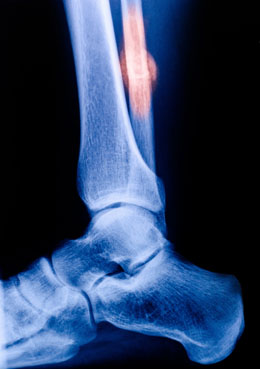Fibula fracture is a common repercussion of any trauma that hits the lower portion of the leg. It is more common in athletes. Let us know about this condition in greater detail from the following.

Fracture of the legs generally include lower leg fractures. Tibia and fibula are the two bones that form the major part of the lower legs and are more prone to fracture because the skin and subcutaneous tissues are very thin over the anterior. The tibia forms the main bone of lower leg and fibula is a smaller bone that runs parallel to the tibia. Since tibia and fibula run parallel to each other any fracture in the tibia automatically breaks the fibula. In rare circumstances, the fibula fracture occurs without any fracture in the tibia.
What Indicates A Fibula Fracture?
A fibula fracture that occurs alone without affecting the tibia, heals faster. The most common symptoms this injury are swelling and tenderness near the fracture site and it may be along outside the lower leg. Discomfort and pain while walking or putting stress on the lower leg are also symptoms of fibula fracture.
Diagnosis
The doctors examine the injured leg for fibula fracture and also check the leg for any type of injury, swelling, deformity, abrasions, bruising and tenderness. Since blood vessels and nerves along the length of the bone can be damaged due to broken bones, the doctor may feel the pulses in that area to examine the damage. The medical expert will also examine your response to touch or pressing the injured area. If there is some damage to the bones, even a slight touch may cause pain. From simplest X-ray tests to Doppler studies method, medical expert may use various methods to confirm the place and severity of the broken bones.
Measures to Tend to the Condition
Fibula fracture that happens without the breaking of tibia can be treated at home after some guidance of a medical expert. Almost all cases of this injury can be treated at home and there is no need of hospitalization. The doctor will guide the patient to rest the injured part and apply cold pack therapy to the injured area. Simple non-steroidal anti-inflammatory drug (NSAID), such as ibuprofen (Advil, Motrin and others) that we normally take in minor fractures can be taken on the recommendation of the doctor.
In case your fracture was severe and it pierced the skin, you will be given intravenous antibiotics into the vein to prevent infection. A tetanus shot is also advised to people who never had a tetanus shot in the past few years.
It takes time for the fibula fracture to heal so in the interim treatment process, your medical expert will advise you to consult some chiropractic expert (or he may also help you learn some physical therapy exercises) that you will be expected to practice as a part of your daily exercise routine. The healing time for fibula fracture is generally for few weeks and it is relatively easier to treat them. In cases of extreme damage to the legs that results in fracture of tibia and fibula or in cases of deep ankle fractures, surgery is the last option.
Fibula fracture can be healed within few weeks and the patient should follow all the prescriptions and recommendations made by the doctor so that there is no strain or tension on the bones during healing period. Avoiding exercises or physical exertion during healing phase is essential so that lower legs have enough time to rest and there is no strain on them.
Disclaimer:
The information provided in this article is solely for educating the reader. It is not intended to be a substitute for the advice of a medical expert.


 Fracture of the legs generally include lower leg fractures. Tibia and fibula are the two bones that form the major part of the lower legs and are more prone to fracture because the skin and subcutaneous tissues are very thin over the anterior. The tibia forms the main bone of lower leg and fibula is a smaller bone that runs parallel to the tibia. Since tibia and fibula run parallel to each other any fracture in the tibia automatically breaks the fibula. In rare circumstances, the fibula fracture occurs without any fracture in the tibia.
Fracture of the legs generally include lower leg fractures. Tibia and fibula are the two bones that form the major part of the lower legs and are more prone to fracture because the skin and subcutaneous tissues are very thin over the anterior. The tibia forms the main bone of lower leg and fibula is a smaller bone that runs parallel to the tibia. Since tibia and fibula run parallel to each other any fracture in the tibia automatically breaks the fibula. In rare circumstances, the fibula fracture occurs without any fracture in the tibia.